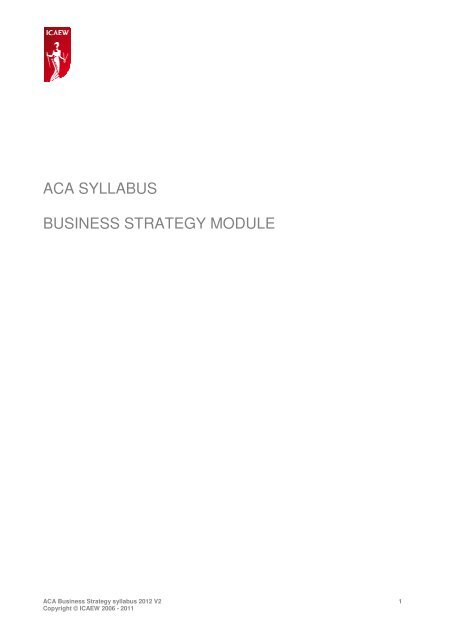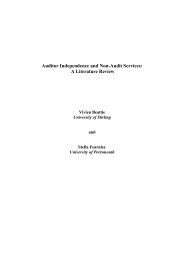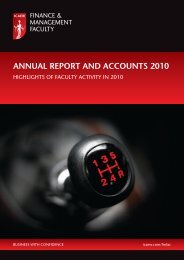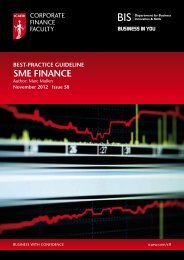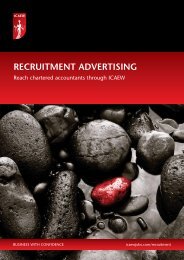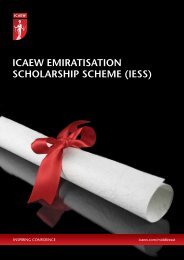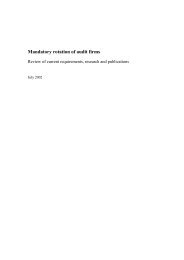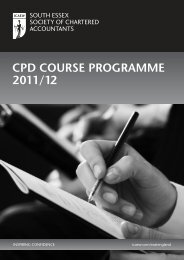ACA | Business Strategy module syllabus 2012 | ICAEW
ACA | Business Strategy module syllabus 2012 | ICAEW
ACA | Business Strategy module syllabus 2012 | ICAEW
Create successful ePaper yourself
Turn your PDF publications into a flip-book with our unique Google optimized e-Paper software.
<strong>ACA</strong> SYLLABUSBUSINESS STRATEGY MODULE<strong>ACA</strong> <strong>Business</strong> <strong>Strategy</strong> <strong>syllabus</strong> <strong>2012</strong> V2 1Copyright © <strong>ICAEW</strong> 2006 - 2011
<strong>ACA</strong> OVERVIEWAimThe <strong>ACA</strong> qualification aims to ensure all newly qualified chartered accountants have the technicaland professional skills to begin their career and from which to build their ongoing professionaldevelopment.StructureThe <strong>syllabus</strong> has been designed to develop core technical, commercial, and ethical skills andknowledge in a structured and rigorous manner. Progression through the <strong>ACA</strong> <strong>module</strong>s, incombination with integrated and monitored work experience, will equip and prepare students forthe demanding multi-disciplinary case study. This final <strong>module</strong> assesses the highest level ofanalysis, synthesis and communication skills, commercial and ethical awareness and theapplication of professional judgement.The diagram above shows the twelve <strong>module</strong>s at the Professional Stage, where the focus is on theacquisition and application of technical skills and knowledge, and the Advanced Stage whichcomprises two technical integration <strong>module</strong>s and the Case Study.Ethics is embedded throughout the qualification and there are specific learning outcomes includedin a number of the <strong>module</strong>s. The <strong>syllabus</strong> has been designed to ensure students understand thefundamental principles of ethics, can apply relevant ethical guidance and are able to recommendactions to resolve ethical issues.<strong>ACA</strong> <strong>Business</strong> <strong>Strategy</strong> <strong>syllabus</strong> <strong>2012</strong> V2 2Copyright © <strong>ICAEW</strong> 2006 - 2011
PROFESSIONAL STAGEAimThe Professional Stage of the <strong>ACA</strong> qualification forms the first stage of formal learning andassessment for the <strong>ACA</strong> and, as such, aims to provide students with the technical skills andunderpinning knowledge to perform their work as trainee chartered accountants in a variety ofenvironments.The Professional Stage <strong>syllabus</strong> has been constructed with the following aims:• to ensure that the required technical knowledge and skills can be learnt and assessed in acomprehensive and rigorous manner• to allow the timing of exam study to be aligned with the knowledge and skills needed in thework place• to enable appropriate educational progression and reinforcement during the study andassessment process.Structure and progressionThere are twelve <strong>module</strong>s in total. Six ‘Knowledge’ <strong>module</strong>s focus on the introduction anddevelopment of core knowledge and skills. The other six ‘Application’ <strong>module</strong>s further develop theknowledge and skills and assess practical technical application.The Professional Stage as a whole forms the foundation of technical knowledge that is furtherdeveloped and integrated at the Advanced Stage.SyllabusThis document presents the learning outcomes for the twelve Professional Stage <strong>module</strong>s. Thelearning outcomes in each <strong>module</strong> should be read in conjunction with the relevant knowledgetables in Appendix 1.AssessmentThe six ‘Knowledge’ <strong>module</strong>s will be examined using computer based assessments. Eachcomputer based assessment will be 1.5 hours in length.The six ‘Application’ <strong>module</strong>s will be examined using traditional paper based assessments. Eachpaper based exam will be 2.5 hours in length.The AAT Top Up paper in Financial Accounting will be 1 hour in length.FlexibilityThere will be no regulations stipulating the order in which students must attempt the ProfessionalStage <strong>module</strong>s, allowing employers to design training programmes according to business needs.Students will be permitted a maximum of four attempts at each <strong>module</strong>.Credit for prior learningStudents with accounting and business related qualifications should visit the <strong>ICAEW</strong> website forfurther information on applying for credit against one or more of the <strong>ACA</strong> <strong>module</strong>s.<strong>ACA</strong> <strong>Business</strong> <strong>Strategy</strong> <strong>syllabus</strong> <strong>2012</strong> V2 3Copyright © <strong>ICAEW</strong> 2006 - 2011
BUSINESS STRATEGYModule aimTo provide students with an understanding of how businesses develop and implement strategy.On completion of this <strong>module</strong>, students will be able to:• identify and analyse the consequences of a business’s current objectives, market positionand direction• evaluate the likely consequences of strategic choices and recommend strategies to meet theobjectives of a business• develop a business plan to achieve a business’s strategic objectives, recommend anappropriate organisational structure and explain the process of effective changemanagement.Specification gridThis grid shows the relative weightings of subjects within this <strong>module</strong> and should guide the relativestudy time spent on each. Over time the marks available in the assessment will equate to theweightings below, while slight variations may occur in individual assessments to enable suitablyrigorous questions to be set.Syllabus area Weighting (%)1 Strategic analysis 352 Strategic choice 353 Implementation and monitoring of strategy 301001 Strategic analysisCandidates will be able to analyse and identify the consequences of a business’s currentobjectives, market position and direction.In the assessment, candidates may be required to:a. evaluate a business’s purpose, in terms of its stated mission, objectives and critical successfactors, highlighting omissions, inconsistencies and weaknesses in its strategicmanagement systems and considering the different objectives of stakeholdersb. analyse for a given situation the external factors which may impact upon a business’sperformance and position, identifying significant issues in areas such as:- sustainability issues- global macroeconomic forces- international trade and financial systems- government policies- industry developments- cultural environment- stakeholder impact- current markets- markets for finance, labour and other resourcesc. analyse a business’s current markets and competitive strategy in sufficient detail fordecisions to be made, drawing conclusions consistent with the data and results andhighlighting relevant issues in terms of their likely impact on the strategy of the business<strong>ACA</strong> <strong>Business</strong> <strong>Strategy</strong> <strong>syllabus</strong> <strong>2012</strong> V2 4Copyright © <strong>ICAEW</strong> 2006 - 2011
d. identify the significance and effect of the internal factors in a given situation which affect ormay influence a business’s ability to achieve its chosen strategy, including its:- current resources- product/service portfolio- organisational and operational capabilities (including core competencies existingbusiness processes, human resource capabilities and information systems capabilities)e. analyse the governance structure of a business identifying strengths and weaknessesf. identify the risk attached to a business’s present position, considering all relevant factors(including attitudes to risk).g. assess a business’ current position and performance from both a financial perspective anda non-financial perspective, using a variety of information sources and data analysis.2 Strategic choiceCandidates will be able to evaluate the likely consequences of strategic choices and recommendstrategies to meet the objectives of a business.In the assessment, candidates may be required to:a. identify and describe in a given scenario the alternative strategies available to a businessb. analyse financial and other data in order to provide information for strategic decisionmakingc. identify the implications for stakeholders, including shareholder value, of choice betweenstrategiesd. identify the risks attached to proposed courses of action in a given situation, considering allrelevant factors (including attitudes to risk) stating all assumptions made and identifyingstrategies for managing riske. show, in a given scenario, how a business chooses from competing strategies in order tomaximise the achievement of its key objectives, including those relating to corporateresponsibility and sustainabilityf. evaluate the ethical implications of a business’s strategies and operations including thosefor the organisation and for individualsg. choose for a given scenario a strategy or combination of strategies which will achieve thebusiness’s objectives and take account of known constraints, including stakeholder riskpreferencesh. explain, in a given scenario, how products and services must evolve in the face of changingconsumer demandi. explain, using information provided, how to position particular products and services in themarket place to maximise competitive advantage and develop a marketing strategy3 Implementation and monitoring of strategyCandidates will be able to develop a business plan to achieve a business’s strategic objectives,demonstrate how data and information can be used to help implement and monitor strategyrecommend an appropriate organisational structure and explain the process of effective changemanagement.In the assessment, candidates may be required to:a. evaluate, in a given scenario, the functional strategies necessary to achieve a business’soverall strategy.b. evaluate the different types of organisational structure and recommend an appropriatestructure for a given strategyc. identify the steps needed for a given business to enable it to meet the appropriateregulations, codes of conduct and disclosure requirements in respect of its governanced. identify methods of further developing a specific business which take account of positionalanalysis and risk and would be most likely to achieve the business’s strategic objectives,and justify the methods selectede. draft a simple business plan, or extracts therefrom, which will achieve given or impliedobjectives<strong>ACA</strong> <strong>Business</strong> <strong>Strategy</strong> <strong>syllabus</strong> <strong>2012</strong> V2 5Copyright © <strong>ICAEW</strong> 2006 - 2011
BUSINESS ANALYSISTopicManagementInformationProfessional Stage<strong>Business</strong> &FinanceFinancialManagement<strong>Business</strong><strong>Strategy</strong>Advanced StageSTRATEGIC ANALYSISEnvironmental and market analysis toolsPEST analysis C A →Porter’s five forces C A →Product life cycle C A →Boston consulting group matrix C A →Competitor analysis C A →Positional and other analysis toolsResource audit C A →Resource-based strategy A →Value chain analysis C A →SWOT analysis C A →Gap analysis C A →Competitor analysis A →Marketing analysis A →Competitive advantage A →Benchmarking A →Directional policy matrixB<strong>Business</strong> process analysis A BStrategic risk analysis A →Balanced scorecard C A →STRATEGIC CHOICE<strong>Strategy</strong> formulation, evaluation and choice C A →<strong>Business</strong> risk management C A →Financial analysis and data analysis A →Stakeholder analysis A →Objectives and stakeholders preferences C BCorporate responsibility and sustainability C BSTRATEGIC IMPLEMENTATION<strong>Business</strong> plans C B AOrganisational structure C B AInformation management C B AChange management A →Project managementACOST ANALYSIS FOR DECISION MAKINGCostingCost classification A →Costing systems – direct, marginal, absorption B →Activity based costing (ABC) C BBreak even analysis B → AMulti-product break even analysisBBudgeting and performance management B APricingPricing decisions B A →Transfer pricing B A →BUSINESS AND SHAREHOLDER VALUE<strong>ACA</strong> <strong>Business</strong> <strong>Strategy</strong> <strong>syllabus</strong> <strong>2012</strong> V2 8Copyright © <strong>ICAEW</strong> 2006 - 2011
TopicManagementInformationProfessional Stage<strong>Business</strong> &FinanceFinancialManagement<strong>Business</strong><strong>Strategy</strong>Advanced StageValuation TechniquesIncome – dividend yield B AIncome – P/E B AIncome – discounted cash flow B AAsset based measures B AOptions approach→Shareholder valueValue based management (VBM)→Value drivers B AShareholder value analysis (SVA) B AShort and long term growth rates and terminal valuesAEconomic profitACash flow return on investment (CFROI)ATotal shareholder return (TSR)AMarket value added (MVA)AINVESTMENT APPRAISAL AND BASIC RISK ANALYSISProject appraisalNPV B A →IRR B A →Payback B A →Relevant cash flows A →Tax and inflation A →Replacement Analysis A →Capital rationing A →Adjusted present value (APV) A →Assessing riskProject appraisal and sensitivity analysis B AProject appraisal and simulation B AExpected values B AScenario planningAGap analysis B →Continuous vs. event risk B →FINANCIAL ANALYSISCost of capitalCost of equity B ACost of debt B ACost of preference shares B ACost of bank loans B AWeighted average cost of capital (WACC) B AEffective interest ratesASplitting convertibles into equity and debt elementsAPublic sector discount ratesAPortfolio theory and CAPMPortfolio theory B <strong>ACA</strong>PM B AAPT and MCPM<strong>ACA</strong>PM and cost of capital B AInternational cost of capitalA<strong>ACA</strong> <strong>Business</strong> <strong>Strategy</strong> <strong>syllabus</strong> <strong>2012</strong> V2 9Copyright © <strong>ICAEW</strong> 2006 - 2011
TopicManagementInformationProfessional Stage<strong>Business</strong> &FinanceFinancialManagement<strong>Business</strong><strong>Strategy</strong>Advanced StageBondsBond pricing using NPVAYields to maturityADuration and price volatilityAConvexityATerm structure of interest ratesACorporate borrowing and default riskASOURCES OF FINANCE AND FINANCING ARRANGEMENTSShort, medium and long term sources of finance B ALoan agreement conditions (warranties; covenants;BAguarantees)Raising capital B AGearing and capital structure A →Loan agreements and covenants A →Dividend policy A →Financing reconstructions (eg: group reconstruction,BAspin off, purchase of own shares, use of distributableprofits)Working capital management C AFINANCIAL ENGINEERINGFutures, options and swapsOptions B AInterest rate futures B AInterest rate options B AInterest forward rate agreements (FRAs) B AInterest rate swaps B AForeign exchangeCurrency forward contracts B ACurrency money market cover B ACurrency options B ACurrency swaps B AOperational techniques for managing currency risk B ATheoretical determinants of foreign exchange rates B AOption valueValue of a call and put optionCBlack Scholes option pricing modelBBinomial Option Pricing ModelBReal options C B<strong>ACA</strong> <strong>Business</strong> <strong>Strategy</strong> <strong>syllabus</strong> <strong>2012</strong> V2 10Copyright © <strong>ICAEW</strong> 2006 - 2011


